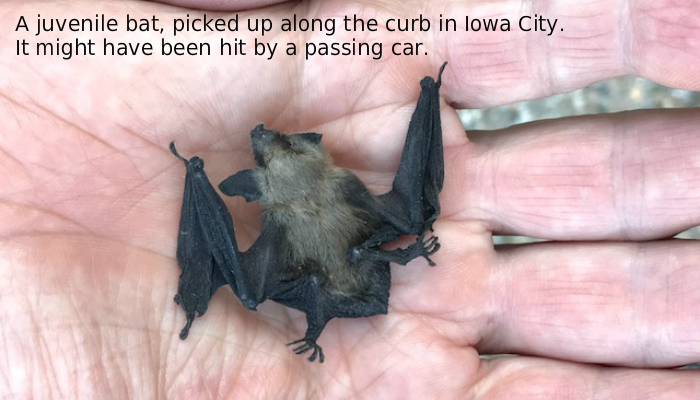Attack Bats? Probably Not

Whether you live in town or out in the country, you might find yourself sharing a room with a flying bat. In summer twilight, bats cruise surfaces – of leaves, of ponds, and along house walls – picking off insects, which have their own agendas on those surfaces. If you open your door quickly in front of one, it must abruptly turn right or left to avoid the door, which could bring it inside. In winter, there might be a couple hibernating in the attic, and when you rummage around to find the holiday decorations, you might disturb them and they may leave via the way you came in.
When you find yourself sharing a room with a flying bat, it is worthwhile to consider the situation from its perspective. Bats share the same aerodynamic limitations as the Wright brothers did, and every aircraft designer since, which is that if you fly too slowly, you go into a stall and tumble out of the air. The fossil record says that bats have understood this for at least 50 million years. When trapped in a room and searching to find a way out, they fly up to the top of the wall to gain altitude, nearly stop, quickly turn, and dive slightly downward to regain airspeed and avoid stalling, only to repeat this on the other side of the room. This puts them looping back and forth across the room, with the low point of their trajectory in the middle of the room. We humans tend to put bookcases, couches, and cupboards around the outer perimeter, which also leaves us standing in the middle of the room. The misunderstanding is people thinking that the bat is diving at them, when all it is doing is trying to manage its airspeed and avoid stalling and crashing.
If you just stand still in the middle of the room, the bat will just fly past you. You are an enormous object on its sonar, and regardless of folklore (“blind as a bat”), it can also see you perfectly well, and will have no trouble avoiding you. It is just a tiny creature trapped in a room with a giant long-armed creature, and is searching for a way out.
Sometimes just opening the door or a window is adequate and it will fly back out. But it might be confused by all the strange-shaped surfaces it is picking up on its sonar, which it has never “seen” before, sorta like you going into a fun house of curved mirrors. Plan B is to just scoop it out of the air with a wide butterfly net and release it outside. But always watch it while indoors because it may tire and duck in behind curtains or other narrow spaces to hide.
The risk of getting rabies in this scenario approaches zero. In 1998 Whitaker and Hamilton (Mammals of Eastern North America, p. 76) stated that “only about 25 people in the United States have ever died of bat rabies,” and some of these were people who had unwisely picked up a bat flopping on the ground. A bat successfully flying in loops back and forth across your living room is a highly coordinated specimen, conducting aerodynamic maneuvers that modern winged aircraft still cannot duplicate, and is not a characteristic of a sick animal.
Today, our bats are in deep trouble. Only a couple of years ago I could canoe out onto our pond in summer twilight and count a dozen bats above and around the water. Last year there were only a few, and this year often none but sometimes one or two.
Wisconsin and Missouri both report that hibernation counts last winter were zero in many caves that formerly had hundreds or thousands of bats. While bats face many threats, most researchers are convinced that the gross mortality in the Midwest is due to white-nose syndrome, the same as it was in the eastern states a few years ago. So it would be a tragedy if one of the rare survivors were to accidentally wind up flying around in someone’s house and it was killed because its motives were misunderstood.


